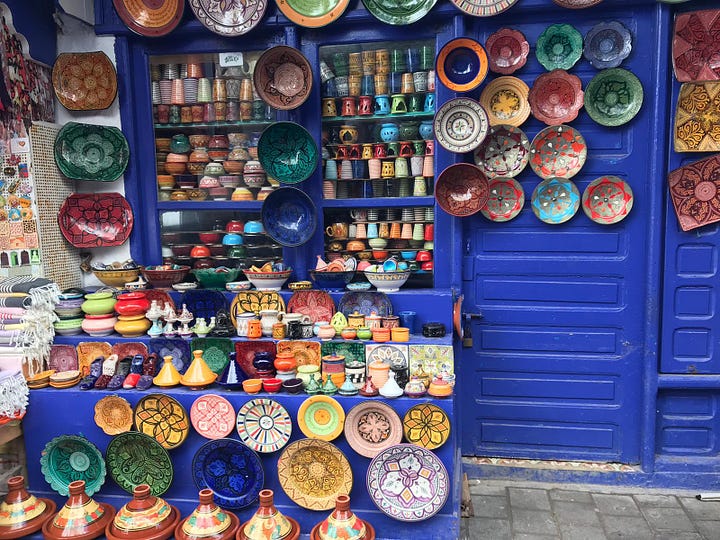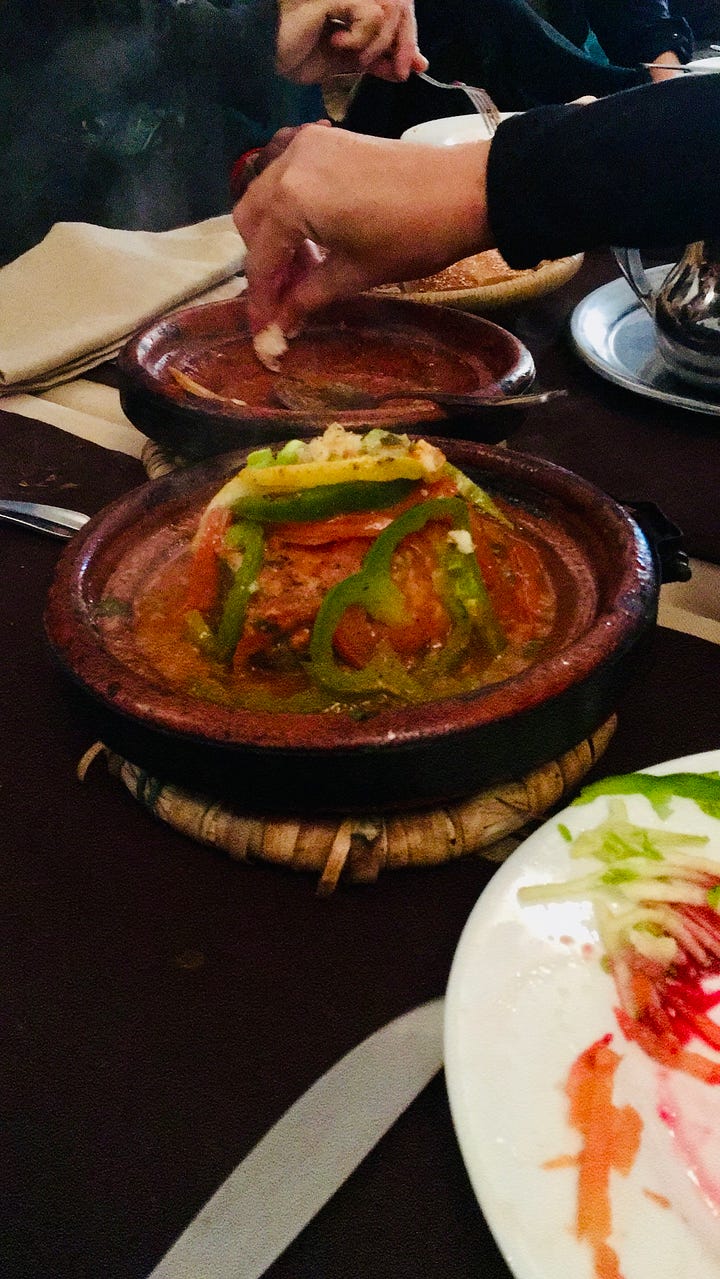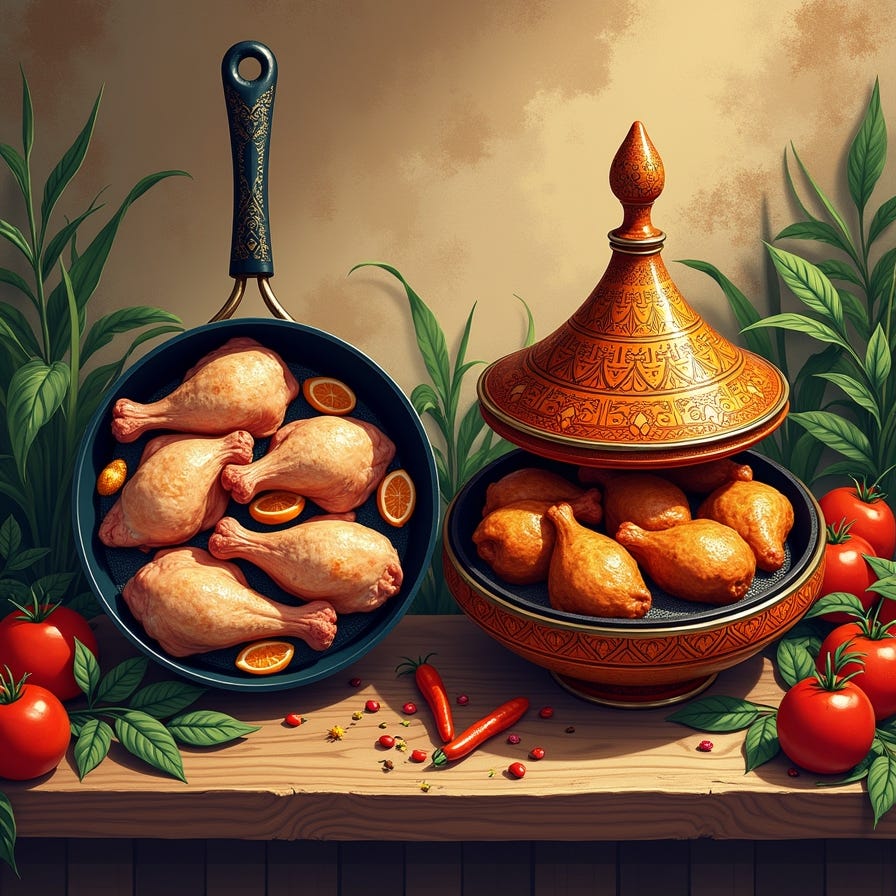LOW-TEMPERATURE & STEAM: THE LONGEVITY HACKS THAT SLASH AGEs AND SLOW AGING
And a Moroccan tajine that keeps flavour high and the ‘sugar-rust’ in your cells low.
WHAT IF THE REAL LONGEVITY HACK…
Isn’t kale vs. carbs, but skillet vs. clay pot? How would your cells feel if tonight’s sear became a slow, fragrant tagine instead?


PART 1. SURF TO SAUFFRON: CLAY POT TAMES FIRE
November 2018. I’m flying to Morocco for sun, waves, and a week of surf lessons. Not for cooking wisdom. Our car arrives at the surf camp around 9 p.m. on a cold night; hunger is howling from our bellies louder than the ocean. The camp in Imssouane sits between the Atlantic coast and the foothills of the Anti-Atlas Mountains.
Inside the main hall, three house cooks (who I later learn are named Latifa, Zahra, and Hiba) are waiting for us, cradling clay pots with cone lids just out of the oven. They usher us inside for dinner and set the pots in front of us. The lid on my pot lifts, and a puff of saffron escapes. Chicken, preserved lemon, olives. Beside it: steaming couscous with seven vegetables. The flavour hits me like a train.
“What’s the secret to this flavour?” I asked one of the women.
“Low heat,” she says, patting the tagine, “and a lot of love.”
I file the thought under Moroccan folklore and start eating. Then a memory grabs me by the neck: a month ago, my Tunisian-French colleague Nourredine raved about “tagine” when I mentioned my trip to Morocco.
I finally connect the dots; the same word for the dish and the pot.
The seed is planted. My rabbit hole begins.
PART 2. THE GOOGLE RABBIT HOLE: MEET THE AGEs VILLAIN
Back in sub-zero Bucharest, I try to replicate the magic in my cast-iron skillet: medium heat, high heat, then oven finish.
They taste good, but something nags at me.
So I start Googling: “Why does tagine taste so moist? How can a skillet mimic tagine texture?” Down the page, a PubMed article catches my eye: “Effect of Traditional Tagine Cooking on Formation of Advanced Glycation End-Products in Lamb Meat.”
“Advanced…what?” I mutter to myself.
Down the rabbit hole I go. Reading through the article, I find answers to my original question and a ton of new information. I get to a different article by Jaime Uribarri, MD. Each new paper gets grimmer.
And the science in these papers? It would ruin my grill forever.
PART 3. AGEs 101: SUGAR, PROTEIN, AND TOO MUCH HEAT
What the heck are AGEs? Simply put, AGEs are compounds of ageing.
According to Dr. Michelle Davenport, a nutrition scientist, there are two types:
Endogenous (made inside the body), and caused by high blood sugar, oxidative stress, and ageing.
Exogenous (eaten or inhaled), caused by charred food, cigarette smoke, or smoggy air.
Let’s focus on the charred foods for a minute.
When sugar meets protein and is heated to 150°C or higher, it forms a brown crust and produces AGEs. This is called the Maillard reaction.
The usual kitchen culprits that promote the formation of AGEs include frying pans, grill grates, ovens, and air fryers.
In contrast, using a tagine, you’ll get: sugar + protein + 95°C steam = tender meat, with minimal AGEs. Lemon, tomato, or yoghurt drops the pH and further blocks the chemistry.
The difference is illustrated in the table below.
Translation: Same chicken, ten-fold fewer AGEs, just by trapping steam.
PART 4. YOUR CELLS ON AGEs: DAMAGE CONTROL
As Dr. Michelle puts it, “AGEs cling to everything from DNA to the collagen in our skin, ageing us from the inside out.”
One in ten slips past your gut wall, glues itself to collagen, and rings a cell doorbell called, no joke, RAGE.
This results in:
Oxidative stress → tired cells
Chronic inflammation → stiff vessels, achy joints
Protein cross-links → wrinkled skin, brittle organs
Blood sugar chaos
A significant aspect of AGEs is absorption.
A 5”2 woman absorbs ≈ the same number of AGE molecules as a 6”2 guy, but has only 2/3 the blood volume to dilute them.
Moral: shrink the browning, not the people.
*All figures are rounded and intended for illustrative purposes only, not clinical use.
The good news: AGEs are hackable.
PART 5. FIRE OUT, STEAM IN: A QUICK KITCHEN FIX
My taste buds loved grill lines. The data? Hated them. Now I picture collagen cross-links and smell my RAGE receptors ringing every time smoke curls off a steak.
I sulked. Briefly. Then I remembered the ace in my sleeve: en papillote.
A French technique I've used countless times: cooking a whole fish in parchment paper with zero char. Proof that a better way existed.
The night before I left Morocco, I bombarded Latifa with questions; the verdict was clear: “Pot with a lid beats flame.”
Every. Single.Time.
Science backs her up. Dr Michelle Davenport talks extensively about water-based cooking + acidic marinades on her Instagram account. I’ve been cooking that way for the last eighteen months; my taste buds haven’t filed a single complaint.
The new longevity math is simple:
Ageing well = (what you eat) × (how you heat it).
Steam, poach, en papillote—sauna inside, zero scorching outside.
Tagine, Dutch oven, slow-cooker—flavour up, AGEs way down.
Acidic marinades—lemon, vinegar, yoghurt: the culinary bouncers that shove AGEs
Ready to taste the proof? Grab a pot—Dutch oven, tagine, whatever holds water and secrets—and test-drive the recipe below.
Try the recipe below, then reply and let me know: did your smoke alarm catch you?
(Then forward this to the friend who thinks “burnt is a flavour.” Their collagen will thank you.)
DUTCH OVEN (OR TAGINE )RICE - THE RECIPE THAT PROVES THE CASE
The inspiration for this uncomplicated recipe came from Cooking for Levi. I adapted my ingredients to what I had on hand at home. It hit the mark and more, so good it turned out.
Serves: 4
Prep time: 5 -10 mins
Cooking time: up to 35 mins (depending on the type of rice you use)
Ingredients:
2 free-range eggs
125-150g white rice (I used a mix of what I had at hand in my home)
4 chicken sausages (or beef/pork)
125-150g greens (broccoli, green beans, sugar snaps, baby bok choy)
500 ml chicken stock
4-5 big shiitake mushrooms
Method:
Wash the rice and add it to a pot with the chicken stock. Set on a low to medium heat and bring to a boil.
Wash and trim the greens and shiitake mushrooms, then dry them; set aside.
Cut the sausages into four chunks. Add the rice to the pot.
* If you’re using white rice, you can cook the veggies, sausages and the greens all together.
* If you’re using black rice or a mix, add the sausages when the rice is cooked halfway through, and the greens when the rice is almost done. This way, you avoid overcooking them.
Serve warm, topped with poached or soft-boiled egg.
As always, thank you for reading Salt, Pepper, Stories. Do share your version of pot rice, and if this post helped you, give it a heart, comment or share it with someone who is on the hunt for delicious and AGEs-friendly recipes.
xx, Ana







